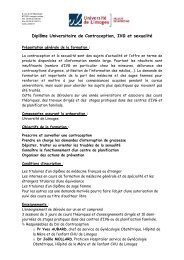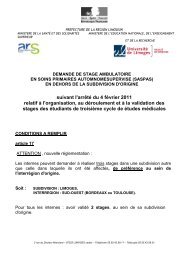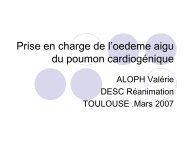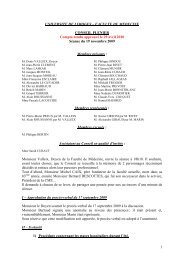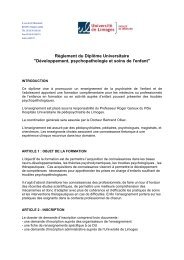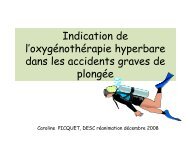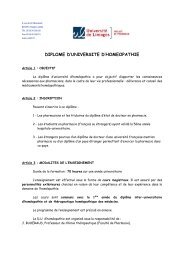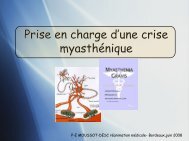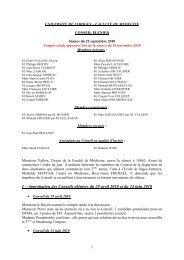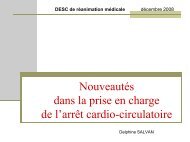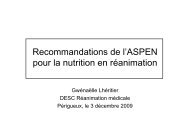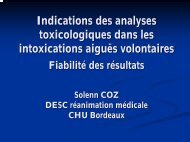Le modèle de Stewart
Le modèle de Stewart
Le modèle de Stewart
- No tags were found...
Create successful ePaper yourself
Turn your PDF publications into a flip-book with our unique Google optimized e-Paper software.
<strong>Le</strong> <strong>modèle</strong> <strong>de</strong> <strong>Stewart</strong>• La variation <strong>de</strong> pH plasmatique n’est npas une variableindépendante:Dépend du <strong>de</strong>grés s <strong>de</strong> dissociation <strong>de</strong> l’eau lplasmatiqueH2O OH - + H +• La concentration en protons dépend d<strong>de</strong> troislois:• Équilibre <strong>de</strong> dissociation électrochimique• Conservation <strong>de</strong> masse• Principe d’electroneutralit<strong>de</strong>lectroneutralité
• Ions Forts:1. Loi <strong>de</strong> dissociation• Complètement dissociés s quelque soit le pH• Ions Faibles:• Dissociation partielle dépendante ddu pH• Obéità la loi <strong>de</strong> dissociation électro-chimiquechimique• pKa: pH pour lequel une fonction aci<strong>de</strong> àlibérer la moitié <strong>de</strong> ces protons : pH <strong>de</strong> ½dissociationpH= pKa + Log ([A-]/[AH])A - : Forme dissociée <strong>de</strong> l’aci<strong>de</strong>AH : forme non dissociée
3. Loi <strong>de</strong> l’electroneutralitlelectroneutralité• Σ <strong>de</strong>s charges positives = Σ <strong>de</strong>s charges négativesn• Appliquée e au Plasma:Σ+ + = Na + + K + + Ca 2+ + Mg 2+ + H +Σ -= Cl - + An - +HCO3 - +alb - +Ph - + OH - + CO2-3CATIONS FORTS : Na + + K + + Ca 2+ + Mg 2+ANIONS FORTS: Cl - + An - avec AN- pour Anions indosésANIONS FAIBLES: HCO3 - +alb - +Ph -OH - + CO 2-3+ H + <strong>de</strong> l’odre ldu nmol/l : négligeablesn
SID : Strong Ion DifferenceCATIONS FORTS : Na+ + K++ Ca2+ + Mg2+Σ(cations ANIONS forts) FORTS: – Σ(anions Cl- + forts) An- avec – Σ AN- (anions pour faibles) Anions= 0indosésSoitSID = A- A + HCO3-Σ(cations ANIONS forts) – FAIBLES: Σ(anions forts) HCO3-+alb= +alb- Σ (anions +Ph-faibles)OH- + CO32Soit+ CO32- + H+ <strong>de</strong> l’odre ldu nmol/l : négligeablesnSID = CATIONS FORTS – ANIONS FORTSAVEC A- : Aci<strong>de</strong>s Faibles dissociées : Albuminates et phopshates
SID « Strong Ion Difference »Aci<strong>de</strong>s faibles : Albuminate et phosphate : A --Albuminate = albumine. (0.123 pH – 0.631)-Phosphate = phosphore . (0.309 pH – 0.469)-HCO3- plasmatique : Équation d’Hen<strong>de</strong>rsondHen<strong>de</strong>rson-HasselbalchHasselbalchSID = 40 +/- 2 mEq/lFORT POUVOIR ALCALINISANT
SID• SID peut également s’és’écrire:(Na + + Ca 2+ + MG 2+ + K +) - (Cl - + lactate - )= SID apparentΣ+ + = Na + + K + + Ca 2+ + Mg 2+ + H +Avec A- A = lactates négligeant nles autres anions•ΣStrong Ion Gap = SID apparent – SID = Anionsindosés - = Cl s - + An sauf lactate- +HCO3 - +alb - +Ph - + OH - + COCO 32-SID = A- A + HCO3-• <strong>Le</strong> SIG est un meilleur indicateur d’anions dindosés s quele trou anionique pour certains auteurs.SID = CATIONS FORTS – ANIONS FORTS
Strong Ion differenceNa +Cl -Anions IndAlbumineSID Ph-Ca 2+Mg ++ HCO3-TrouAnionique
Principe <strong>de</strong> <strong>Stewart</strong>• Plasma: : Solution aqueuse contenant <strong>de</strong>s ionsforts et <strong>de</strong>s aci<strong>de</strong>s faibles équilibrée à unepression partielle en CO 2• Modifier le pH n’est npossible qu’en agissant surune <strong>de</strong>s trois variables indépendantes:• SID• Concentration Aci<strong>de</strong>s Faibles Totales• Pressions partielle en CO2
<strong>Le</strong> pH dépend ddonc <strong>de</strong> 3 variablesindépendantes1. La différence entre CATIONS FORTS et lesANIONS FORTS plasmatiques :2. La PaCO23. La masse totales <strong>de</strong>s aci<strong>de</strong>s faibles :Atot : Albumine et phosphore InorganiqueEt entraînent nent <strong>de</strong>s variations <strong>de</strong>s variablesDEPENDANTES : pH, Bicarbonates, formesdissociées <strong>de</strong>s aci<strong>de</strong>s faibles
La variation <strong>de</strong> laconcentration plasmatiqueen bicarbonate est doncune conséquence<strong>de</strong> lamodification <strong>de</strong> l’él’équilibreacido-basique.
6 équations <strong>de</strong> <strong>Stewart</strong>
Métho<strong>de</strong> d’explorationd
Métho<strong>de</strong> d’exploration dcomplémentairementaire
Interet du concept• Concept permettant d’approcher dles troublescomplexes acido-basiquesrencontrés s en réanimationr• Trouble acidobasique simple: : Une anomalie sansautre perturbation.• Trouble Mixte: : association d’une dperturbationmétabolique et respiratoire allant dans le même sens.• Trouble complexe: : association <strong>de</strong> <strong>de</strong>ux ou troistroubles simples qui ne vont pas dans le même sens:Acidose et alcalose métabolique massociéesà un seultrouble ventilatoire (acidose ou alcalose)
SID = CATIONS FORTS – ANIONS FORTSACIDOSES métaboliques mselon <strong>Stewart</strong>• Diminution du SID:• Hyponatrémie• Hyerchlorémie• Hypomagnésémiemie• Augmentation <strong>de</strong>s Anions indosés s et lactates• Augmentation <strong>de</strong>s Aci<strong>de</strong>s Faibles:Σ+ + = Na + + K + + Ca 2+ + Mg 2+ + H +• Hyperphophorémie• Hyperalbuminémie Σ - = Cl - + An - mie +HCO3 ou - +alb gammapathie - +Ph - + OH - + monoclonaleCO2-3SID = A- A + HCO3-
Acidoses/Alcaloses selon <strong>Stewart</strong>ACIDOSE RESPIRATOIRE• Augmentation <strong>de</strong> la PaCO2ALCALOSE RESPIRATOIRE:• Diminution <strong>de</strong> la PaCO2
ALCALOSE métabolique mselon <strong>Stewart</strong>• Augmentation du SID:• Hypernatrémie• Hypochlorémie• Hypermagnésémiemie• Diminution <strong>de</strong>s aci<strong>de</strong>s faibles:• Hypoalbuminémiemie• HypophosphorémieΣ+ + = Na + + K + + Ca 2+ + Mg 2+ + H +Σ -= Cl - + An - +HCO3 - +alb - +Ph - + OH - + CO2-3SID = A- A + HCO3-
Situation en équilibre physiologiqueJacques <strong>Le</strong>vraut. XXXIVème congres <strong>de</strong> la société <strong>de</strong> languefrançaise <strong>de</strong> Réanimation médical. 2006
Acidose par excès s d’anions dindosésCharge <strong>de</strong> 10 mmolD’aci<strong>de</strong> lactiqueJacques <strong>Le</strong>vraut. XXXIVème congres <strong>de</strong> la société <strong>de</strong>langue française <strong>de</strong> Réanimation médical. 2006
Alcalose par HypoalbuminémiemieJacques <strong>Le</strong>vraut. XXXIVème congres <strong>de</strong> la société <strong>de</strong> languefrançaise <strong>de</strong> Réanimation médical. 2006
Trouble mixteJacques <strong>Le</strong>vraut. XXXIVème congres <strong>de</strong> la société <strong>de</strong> languefrançaise <strong>de</strong> Réanimation médical. 2006
Cas Clinique• Homme <strong>de</strong> 56 ans• Hospitalisé pour intoxication médicamenteusemvolontaire.• Glasgow 6, Hémodynamique Hprécaire• Absence d’amdamélioration du Glasgow aprèsAnexate® iv en titration.• Remplissage par Colloï<strong>de</strong> et NACL isotonique9%0Décision d’intubation dorotrachéaleale
BiologieGDS: pH = 7.15 ; PaCO2 = 34.2 mmHg ; PO2=340 mmHg ;BE=-13 ; HCO3 - calc=8.2 mmol/lACIDOSE METABOLIQUE NON COMPENSEEIonogramme sanguin : NA+=139mmol/l;K+=6.3mmol/l;Cl - =117mmol/l; Ca2+= 1,87mmol/l; CO2T= = 9.2 mmol/l;Mg=0.83mmol/l;Lactate - =1,2 mmol/lCalcul du trou anionique: TA = 139 – (116 + 9) = 12ACIDOSE METABOLIQUE HYPERCHLOREMIQUE
• Calcul <strong>de</strong> la PaCO2 attendue par l’ l Équationd’Hen<strong>de</strong>rson-Hasselbalch Hasselbalch :PCO2 théorique = 29 mmHg (Vs PaCO2mesurée= e= 34.2 mmHg )Acidose ventilatoire associée
• Acidose MIXTE:Diagnostic Évoqué:• Acidose métabolique mhyperchlorémique avec trouanionique normal• Acidose respiratoire ( réglage r<strong>de</strong>s paramètres duventilateur)POSSIBILITE d’erreur DIAGNOSTIC :Contexte clinique ++++Deman<strong>de</strong> complémentaire:mentaire:Albumine = 21 g/l ; Phosphore: : 1.25 g/l
Selon STEWART• SID =5.2+2.2+9 = 16.4• SID apparent Σ+ + = Na = + + 148 K + + – Ca 118 2+ + =30Mg 2+ + H +• ΣSIG - = Cl = - 30 + An – 16.4 - +HCO3 = 13.6- +alb - +Ph - + OHSID = CATIONS Présence FORTS d’anions dindosés• Variation du SID = supérieurA- A + HCO3-à celle <strong>de</strong>sbicarbonate (Na:+ + Ca 2+ + MG 2+ + K +) - (ClOH - + COSID = CATIONS FORTS – ANIONS FORTSSID apparent = (NaVariation SID SIG (40-16.4= = SIDa 23.6)- SIDVariation Bicarbonate (26-9 9 = 17)Albuminate = albumine. (0.123 pH – 0.631)-Phosphate = phosphore . (0.309 pH – 0.469)CO 32-(Cl - + lactate - )Alcalose métabolique m/ hypoalbuminémiemie-HCO3- plasmatique : Équationquation d’Hen<strong>de</strong>rson-HasselbalchHasselbalch
SUSPICION +++++ d’intoxicationdà l’AntigelANTIDOTE par FOMEPIZOLE-Amélioration clinique-Intoxication confirmée à un dérivdrivé <strong>de</strong> l’él’éthylèneGlycol par chromatographieCONCLUSION:Acidose mixte:-respiratoire-Métabolique( EthylAlcalose Métabolique:M-Hypoalbuminémiemie( Ethylène Glycol et hyperchlorémie)
Conclusion• Plus qu’un un concept : un Interet réelr• A intégrer dans la pratique quotidienne• Formation et éducations <strong>de</strong>s réanimateurs ret<strong>de</strong>s personnels <strong>de</strong> soins intensifs• Implication thérapeutique certaine



